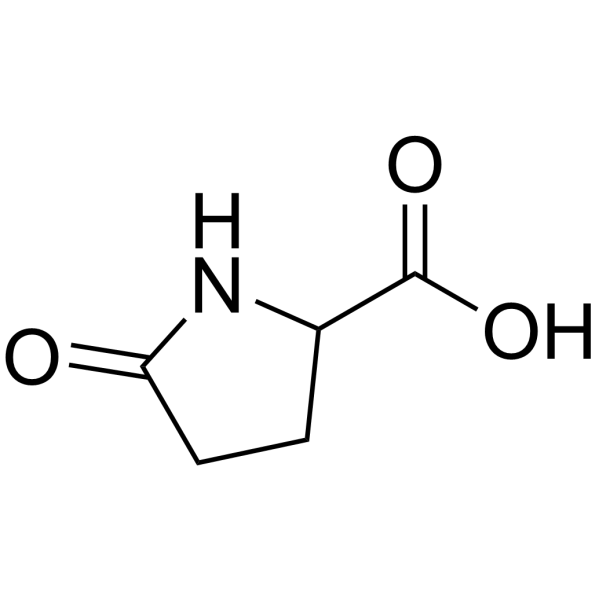Physicochemical Properties
| Molecular Formula | C5H7NO3 |
| Molecular Weight | 129.11 |
| Exact Mass | 129.042 |
| CAS # | 149-87-1 |
| Related CAS # | DL-Pyroglutamic acid-d5;352431-30-2 |
| PubChem CID | 499 |
| Appearance | White to off-white solid powder |
| Density | 1.4±0.1 g/cm3 |
| Boiling Point | 453.1±38.0 °C at 760 mmHg |
| Melting Point | 180-185ºC |
| Flash Point | 227.8±26.8 °C |
| Vapour Pressure | 0.0±2.4 mmHg at 25°C |
| Index of Refraction | 1.512 |
| LogP | -2.39 |
| Hydrogen Bond Donor Count | 2 |
| Hydrogen Bond Acceptor Count | 3 |
| Rotatable Bond Count | 1 |
| Heavy Atom Count | 9 |
| Complexity | 154 |
| Defined Atom Stereocenter Count | 0 |
| InChi Key | ODHCTXKNWHHXJC-UHFFFAOYSA-N |
| InChi Code | InChI=1S/C5H7NO3/c7-4-2-1-3(6-4)5(8)9/h3H,1-2H2,(H,6,7)(H,8,9) |
| Chemical Name | 5-oxopyrrolidine-2-carboxylic acid |
| HS Tariff Code | 2934.99.9001 |
| Storage |
Powder-20°C 3 years 4°C 2 years In solvent -80°C 6 months -20°C 1 month |
| Shipping Condition | Room temperature (This product is stable at ambient temperature for a few days during ordinary shipping and time spent in Customs) |
Biological Activity
| ln Vitro | DL-Pyroglutamic acid results 50 and 100%, respectively, inactivation of the antigen at 0.01-0.025% and 0.025-0.05%[1]. According to Druce and Bradford, DL-pyroglutamic acid may be a glutamate antagonist since it inhibits the glutamate miniature-end-plate potential in locust muscle [2]. |
| ln Vivo | DL-Pyroglutamic acid (0.775 mM/L) cobalt implantation in the sensorimotor cerebral cortex completely eliminates the myoclonic jerks and EEG spikes in rats model of epilepsy[2]. |
| References |
[1]. N-alpha-Cocoyl-L-arginine ethyl ester, DL-pyroglutamic acid salt, as an inactivator of hepatitis B surface antigen. Antimicrob Agents Chemother. 1979 Sep;16(3):329-32. |
| Additional Infomation |
5-oxoproline is an oxoproline having the oxo group placed at the 5-position. It is an intermediate metabolite in the glutathione cycle. It has a role as a human metabolite. It is a pyrrolidinemonocarboxylic acid, a member of pyrrolidin-2-ones and an oxoproline. It is a conjugate acid of a 5-oxoprolinate. DL-Pyroglutamic acid has been reported in Drosophila melanogaster, Mycoplasma gallisepticum, and other organisms with data available. A cyclized derivative of L-GLUTAMIC ACID. Elevated blood levels may be associated with problems of GLUTAMINE or GLUTATHIONE metabolism. |
Solubility Data
| Solubility (In Vitro) | DMSO : 100 mg/mL (774.53 mM) |
| Solubility (In Vivo) |
Solubility in Formulation 1: ≥ 2.5 mg/mL (19.36 mM) (saturation unknown) in 10% DMSO + 40% PEG300 +5% Tween-80 + 45% Saline (add these co-solvents sequentially from left to right, and one by one), clear solution. For example, if 1 mL of working solution is to be prepared, you can add 100 μL of 25.0 mg/mL clear DMSO stock solution to 400 μL PEG300 and mix evenly; then add 50 μL Tween-80 + to the above solution and mix evenly; then add 450 μL normal saline to adjust the volume to 1 mL. Preparation of saline: Dissolve 0.9 g of sodium chloride in 100 mL ddH₂ O to obtain a clear solution. (Please use freshly prepared in vivo formulations for optimal results.) |
| Preparing Stock Solutions | 1 mg | 5 mg | 10 mg | |
| 1 mM | 7.7453 mL | 38.7267 mL | 77.4533 mL | |
| 5 mM | 1.5491 mL | 7.7453 mL | 15.4907 mL | |
| 10 mM | 0.7745 mL | 3.8727 mL | 7.7453 mL |
